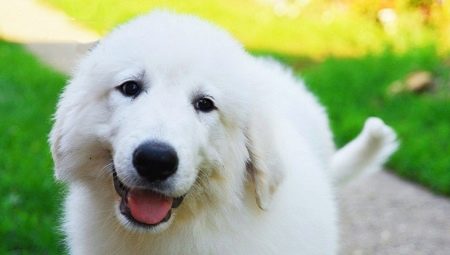Pyrenean wolfhound, Pyrenean mountain dog or Pyrenean wolfhound - the same breed of dogs can be called, very similar to a polar bear. We are talking about the Pyrenees mountain dog - a loyal and reliable guard and at the same time a friendly companion.
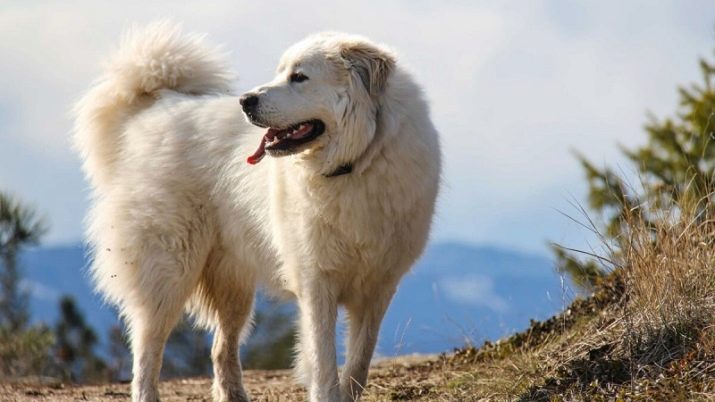

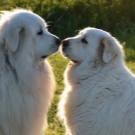
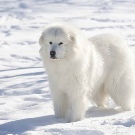
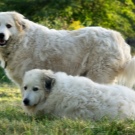

Origin history
Pyrenean Mountain Dog is of French origin. It is believed that its ancestors were very large dogs that lived in the distant past in Asia. This is confirmed by excavations: the remains of such large dogs that lived 6000-8000 years ago were found. In the French Pyrenees, where they first appeared, they were used as shepherds of sheep flocks. Accurate data on how they found themselves in Europe does not exist, but it is assumed that they came along with tribes of nomads from Asia. Bold dogs with great endurance and strength were not only guards, but also endured a heavy burden.
Here, in conditions of mountain isolation, where white dogs coexisted next to the local Basque dogs, natural hybridization occurred and the formation of the characteristics necessary for man.
It is also assumed that other breeds, as well as the gray European wolf, participated in the creation of these giants.
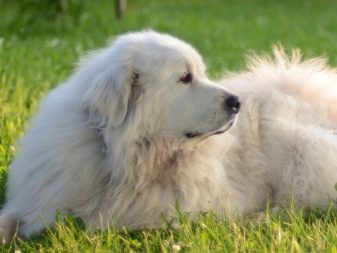
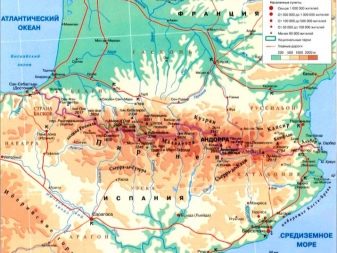
In the French Pyrenees there is a legend about where these huge dogs came from. It tells of a girl who got lost in the winter in the mountains. By night, she completely weakened and froze, and began to pray to God for salvation. Suddenly, the huge snowdrifts turned into giant dogs, which warmed her with their warm thick coat. In the morning, smart dogs took the child to the village.Grateful parents provided shelter for the dogs, and they became a reliable protection against ill-wishers and wild animals.
In later times, white guards began to be used to protect border castles and fortresses. This is confirmed by documentary records of the beginning of the XV century. So, gradually the breed gains popularity, and in the XVII century (specifically in 1675) the Pyrenees mountain appeared at the French court of Louis XIV, which gave them the status of court guards.

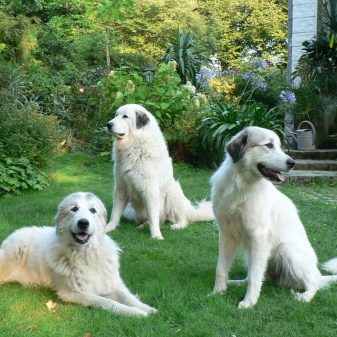
These giants were loved for their beauty, obedient and seasoned disposition. Their population is growing, and in the XVII-XVIII centuries. France becomes their exporter to other European states (England, Italy). The first registered breed was presented at a dog show in 1885, but only in 1907 the standard of the Pyrenean mountain dog was officially confirmed.
World wars of the first half of the 20th century led to an almost complete loss of these beautiful animals. However, the French and Spanish like-minded dog handlers, having found dogs in the remote Pyrenees mountains, gradually restored the breed. It was again officially recognized in 1960. In 1986, international cynological organizations and FCI finally approved the breed standards. Currently, the number of these wonderful dogs is not so large compared to other breeds. Now they are almost never used as sheep shepherds. Usually they perform a security function, or they are ordinary pets.
They are most popular in Europe, America, and also in Japan. In our country, the breed is little known, but gradually gaining popularity.
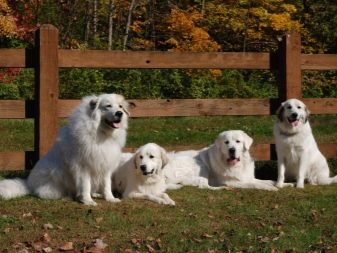
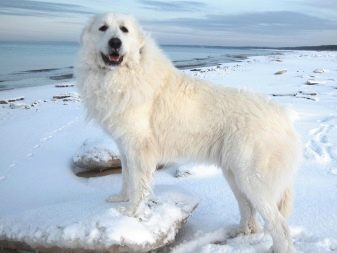
Description
The appearance of this large mountain beauty is striking in its representativeness, harmony, beautiful snow-white coat and huge size. Its overall appearance with large dimensions is harmonious and elegant. Their wool is usually dyed white, but spots of light gray, fawn, badger or red shades are possible, but they are never black. Spots should not be more than a third of the total coat. They have a characteristic arrangement: on the head and near the ears, on the basal part of the tail, sometimes spots can also be on the body.
Coat with a soft, thick, dense and short undercoat is straight and long, but slightly stiff, well-fitting to the body. Short hair grows on the head, and longer hair on the tail, nape and “panties”. Curly hair is a defect in the exterior.
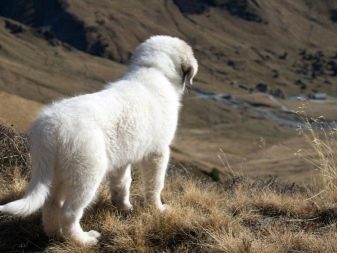
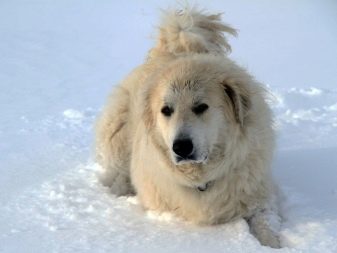
The breed standard is considered a few basic features.
- The size of the head compared with the entire body is relatively small. Her appearance is distinguished by nobility and grace. The skull has a regular shape with a pronounced occipital protuberance. A wedge-shaped, rather wide muzzle with flat cheeks has a smooth transition from the forehead to the nose. The cheekbones and arches above the eyebrows are weakly expressed. On a white coat, lips and nose are beautifully black. The bite of powerful jaws has a scissor appearance - the upper lip is slightly lowered to the lower. The number of strong white teeth is 42.
- Particular attention is paid to the expression of the dog’s eyes: it should be spiritualized - thoughtfully smart, slightly sad. In combination with a “smile”, this look gives the whole face a characteristic, unique and unique so-called Pyrenean expression. The color of the eyes of white dogs is brown with an amber hue, they have a slightly slanting almond-shaped shape.
- The medium-sized hanging, short-haired ears have the shape of a rounded triangle. From the outer edge of the eyes to the base of the ears there is a noticeable feature that appears as a result of the fusion of the hair of the upper part of the muzzle with the lower.
- The dogs have a muscular neck of medium length with a pronounced nape.
- The elongated body has a wide chest, a long, with strongly developed muscles back, “hill”, which slightly decreases to the tail.
- A low-set tail, covered with long and thick hair, can rise above the back when running and walking, but not too high.
- Straight legs stand parallel to each other. The muscles on them are very well developed. On closed fingers are dense pads. The hind legs have 6 toes, not 5. The two thumbs located above the other two thumbs were in the old days special “cats” that facilitated movement in mountainous terrain. The joints on the legs stand out well, but they are not visible under the coat. Joint nodes have a direction exactly back and are located under the body.
- The weight of an adult male and female is slightly different. A male weighs about 60 kg with a height at the withers of about 80 cm, and a female weighs about 55 kg with a height of 65 to 72 cm.
A feature of the large Pyrenean wolfhound is its ability to bark loudly and a lot at any sounds, especially at night, which is typical for guard dogs.

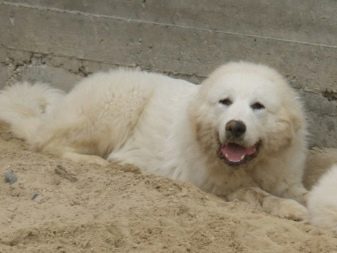
Character
Despite its formidable appearance, the Pyrenees hound has a calm, balanced disposition, it lacks aggression and fighting qualities. It is characterized by natural nobility, intelligence and courage. This giant is very faithful to the owner and all members of the household. Brave dogs take care of all family members, taking them under their protection. To achieve obedience, already at the age of 4 months the puppy needs to be treated with rigor and inflexibility, since it is at this time that they begin to show their character and excessive independence. The owner must become a real leader for the dog, otherwise she will not obey.
These dogs also have some kind of freethinking and independence.therefore, they can easily escape if the opportunity presents itself. Possessing independent thinking, they consider everything around their territory.
This trait of character inherited from the shepherd’s past.
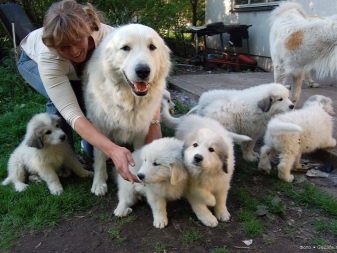
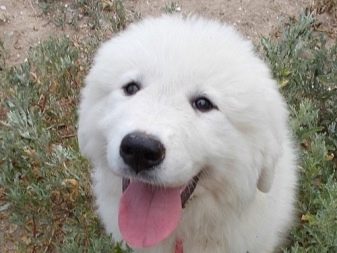
The natural genetic qualities of guards and defenders are manifested in a wary, but non-aggressive attitude towards strangers. Dogs first look at strangers and, making sure that they are not a threat, allow them to approach and let themselves stroke. When a stranger appears, they are able to growl menacingly, bite their teeth and bark loudly if they suspect evil intentions. In combination with their menacing appearance, such behavior makes them excellent watchmen and defenders, better than direct aggression. Dogs perform their protective functions diligently, diligently and carefully.
The proud nature and self-esteem of the Pyrenean dog does not tolerate unceremoniousness from strangers, as well as rude and even more cruel treatment of household members. However, even in this case, the dog can only growl warningly.
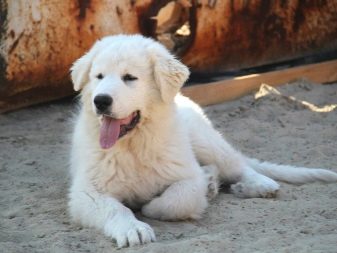

Despite its impressive size, the white dog is mobile and restless, very fond of playing and naughty, especially with children. In relation to them, she shows great condescension and tolerance, is able to endure all children's amusements. White giants are kind and affectionate by nature. These qualities allow them to be used in rehabilitation centers for children with developmental defects.
They get along well with other available pets, even cats. Mountain dogs can easily endure prolonged loneliness. Although they have a sociable disposition, pets will never impose their presence.
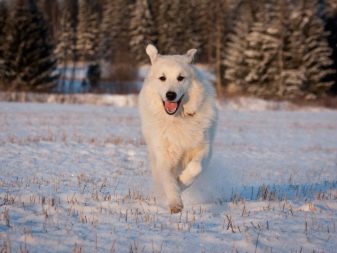

Life span
As a legacy from his ancestral shepherds, who lived in harsh conditions, the Pyrenean wolfhound received good health. Dogs have strong immunity. Their life expectancy can reach 10-12 years. However, the longevity of the dog is greatly influenced by the conditions of detention and nutrition.
Despite good health, a white dog may develop some diseases.
- Dysplasia of the extremities, which usually occurs in large dogs due to a large load on the joints.
- Skin problems arise due to the thick undercoat, especially if the dog lives in a hot climate.
- The structure of tight-fitting ears does not provide the necessary ventilation. This can cause ear diseases.
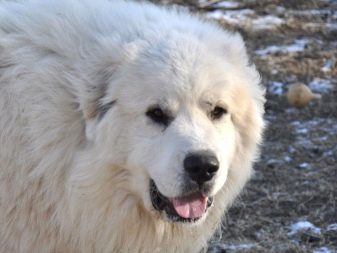
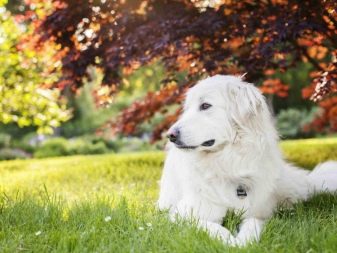
And also white giants do not tolerate small rooms, a long stay in which can cause dangerous diseases. For health, they need to live in a large area where there is the opportunity to actively move.
Proper care and monitoring of the general condition of the pet will not only save his health, but also increase his life expectancy.

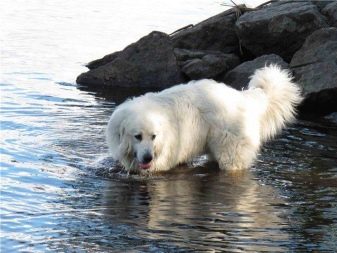
How to choose a puppy?
Since this is a rather rare breed, buying a puppy of a Pyrenian mountain dog is necessary only in nurseries from breeders specializing in breeding of this particular breed. It is not recommended to purchase a puppy from resellers, because you can fall for deception and get, instead of a thoroughbred Pyrenean wolfhound, puppies of the Pyrenean or Caucasian Shepherd very similar to it, more common and cheaper.
You can get lists and addresses of such kennels at local dog clubs. If there is no opportunity to personally see the puppy due to the distant location of the kennel, it is recommended not to select it from the photograph, but to request a video with the puppy. During a personal examination, it is necessary to see the parents in order to assess the working abilities, their character and behavior. We need to evaluate the environment in which the dogs live. They should not be kept in cramped cages or enclosures.
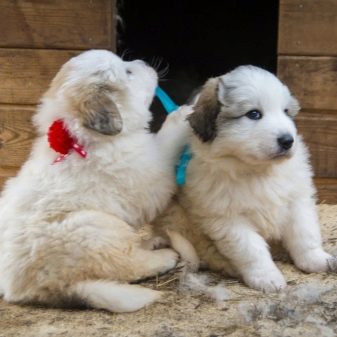
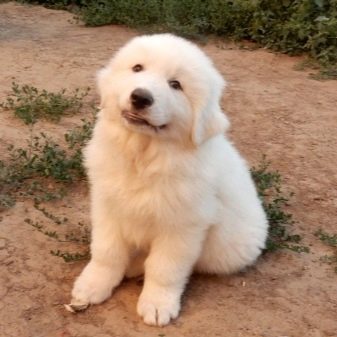
The territory of the kennel should be quite spacious for the active life of dogs. The more animals move, the faster and more harmoniously their physical and psychological development occurs. No need to rush to choose a puppy: first you need to watch all the babies in the litter. Healthy puppies are quite active, cheerful and cheerful, and they should look well-groomed. It is advisable that they be already socialized. All puppies in the litter should have approximately the same size, proper physique and resemble each other.
In white dogs, sexual dimorphism is very well developed (gender difference), so you need to see if the sex of the puppies is well defined.
Boys have a larger complexion and a head, and the muzzle has a more fearless Pyrenean expression.

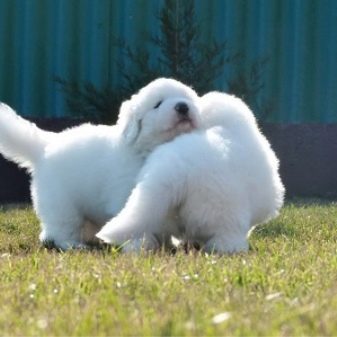
A healthy puppy is distinguished by a strong, voluminous and proportional physique. The chest is long and wide, the stomach is elastic and slightly taut. Particular care must be taken to examine the puppy's paws. They should be straight, fairly thick, and their setting moderately wide. On the hind legs, the presence of two extra (arrived) fingers is mandatory - this is a sign of thoroughbred.
Puppy size also matters. A 2-month-old puppy weighing less than 7 kg indicates either a genetically small dog or malnutrition. At the age of three months, he should not weigh less than 12 kg, and usually his weight ranges from 14-19 kg. The selected puppy must be at least two months old. Socialized puppies with a good and normal psyche do not lower their eyes, but look directly at the person, showing interest and goodwill. A specific Pyrenean look is also a sign of the breed.

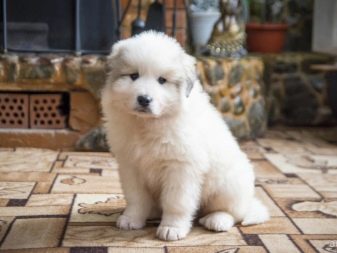
Conditions for keeping
The Pyrenean Wolfhound is completely unsuitable for urban conditions and living in an apartment. Such a dog loves space and freedom. Therefore, it is better to keep it in a private house outside the city with a large garden. It is also impossible to chain and position a white dog in a cage. An animal kept under such conditions will often become ill and weaken. On the street, it is necessary to equip a spacious aviary with a large pet booth for sleeping and relaxing. You can also let the dog home for the night, but she must spend the day outside. The white giant is very well adapted for living outside the house and is not afraid of either snow, rain or cold.
It is impossible to place the booth near the fence, since the dog, having easily jumped onto the booth, will jump over the fence. The best place for her is near the house, and the entrance to the booth should have a direction to the door to the house and the entrance gate so that the dog sees them.
It is better to enclose the household territory with a high (about 1.8 m) fence, brick or metal.
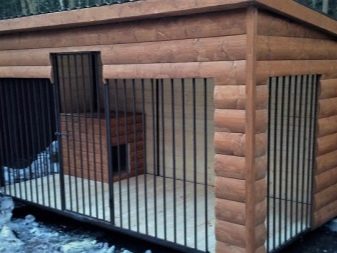
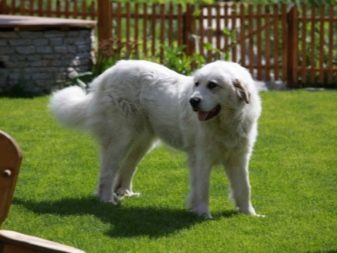
What to feed?
By nature, dogs are predatory animals. Their teeth are designed to tear meat and gnaw bones, and the esophagus is to swallow large pieces of meat that are easily digested with saturated gastric juice. When organizing catering for the Pyrenean Wolfhound, this fact must be taken into account. Experienced breeders and dog breeders recommend natural food for this dog. The main part of the food (about 2/3) should be protein products: non-fat any meat, offal, oily sea fish, eggs, which are preferably fed raw. Fresh scar is also very useful for dogs. It is sometimes allowed to give meat boiled.
Supplementing protein foods is necessary with different vegetables and fruits, which are also given raw. Coarse fiber forms the right intestinal microflora. Boiled vegetables are useless in this regard. Porridge can also be given. But you need to remember that this is a source of carbohydrates that contribute to the accumulation of fats. They can feed the dog in winter, when additional energy is needed. The norm of cereals for one week is 1 glass.
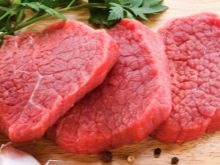


Dog nutrition should be supplemented with mineral and vitamin complexes, which are given strictly according to instructions or after consultation with a veterinarian. In addition, it is also recommended to add sunflower oil or other oil (2 tablespoons) every day, which can be replaced with oily sea fish (100 g) as sources of useful polyunsaturated acids. It is useful to include brewer's yeast (2-3 tablets), bran (1 tablespoon) and fish oil (0.5 teaspoon) in the diet, and pamper the pet with honey and other apiary products 2 times a week.
It is impossible to overfeed a dog in order to prevent obesity, which negatively affects the joints and spine. To prevent this, you need to remove the feeder immediately, as soon as the dog eats - it takes her 10 to 15 minutes. The daily rate directly depends on the degree of activity of the dog and the conditions of its maintenance. In winter, these norms are almost doubled to maintain the necessary energy balance. In addition to natural, dry feed is also allowed. But there is a requirement for their quality: feed should not be lower than the premium, and preferably even super-premium.
With any type of nutrition, fresh water should always be available to the dog in unlimited quantities.



How to care?
Caring for a Pyrenean dog consists in conducting routine activities. One of the important points is hair care. Although the dog’s coat has the ability to repel dirt and water, it needs to be combed regularly, about 2-3 times a week, and during molting - daily. White coat does not get dirty a lot, therefore, a pet should not be washed often: 4 times a year is enough. From frequent bathing, the hair becomes thin, it weakens and can fall out. If the pet participates in exhibitions, then when bathing, you can use special shampoos with a whitening effect. Such a shampoo eliminates the yellowness of the hair in the area of the mouth and eyes, on the legs and lower abdomen.
It’s also important to know that it is impossible to cut the hair of white dogs, as this leads to skin problems. But you need to regularly inspect the skin, as thick hair can hide wounds and other injuries, as well as skin allergies. Care is required for the ears of the animal. They should be inspected weekly and, if necessary, wiped with cotton swabs moistened with a special tool. In addition, you should brush your dog’s teeth, look after your eyes and cut their nails. This is especially true for claws on dewclaws, since they themselves do not grind on them.If the nails are not trimmed, they can tuck and stick into the skin.
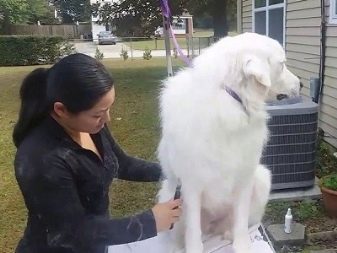

And also carry out such standard events:
- need regular and timely vaccinations;
- treat wool with parasite products;
- daily inspect the coat to exclude the possible presence of ticks;
- regularly prevent the infection of worms with special drugs.
Of course, not everyone can buy such a dog, costing from 35 to 90 thousand rubles. But if there is such an opportunity and suitable conditions for its maintenance, then the Pyrenees mountain dog will become both a reliable defender and a faithful companion.

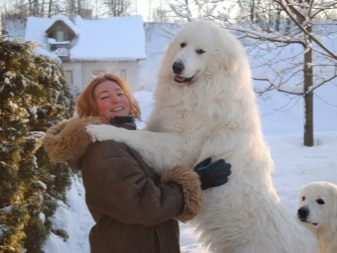
In the next video you will find interesting facts about the Pyrenees mountain dog.
